Xiaoli Liu
SynMatch: Rethinking Consistency in Medical Image Segmentation with Sparse Annotations
Aug 10, 2025Abstract:Label scarcity remains a major challenge in deep learning-based medical image segmentation. Recent studies use strong-weak pseudo supervision to leverage unlabeled data. However, performance is often hindered by inconsistencies between pseudo labels and their corresponding unlabeled images. In this work, we propose \textbf{SynMatch}, a novel framework that sidesteps the need for improving pseudo labels by synthesizing images to match them instead. Specifically, SynMatch synthesizes images using texture and shape features extracted from the same segmentation model that generates the corresponding pseudo labels for unlabeled images. This design enables the generation of highly consistent synthesized-image-pseudo-label pairs without requiring any training parameters for image synthesis. We extensively evaluate SynMatch across diverse medical image segmentation tasks under semi-supervised learning (SSL), weakly-supervised learning (WSL), and barely-supervised learning (BSL) settings with increasingly limited annotations. The results demonstrate that SynMatch achieves superior performance, especially in the most challenging BSL setting. For example, it outperforms the recent strong-weak pseudo supervision-based method by 29.71\% and 10.05\% on the polyp segmentation task with 5\% and 10\% scribble annotations, respectively. The code will be released at https://github.com/Senyh/SynMatch.
What Is Next for LLMs? Next-Generation AI Computing Hardware Using Photonic Chips
May 09, 2025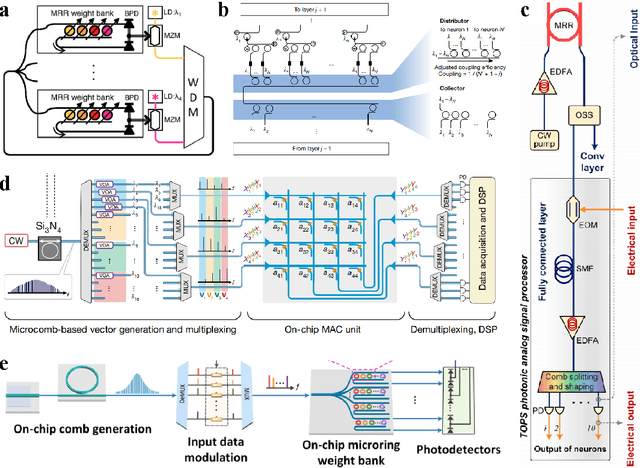
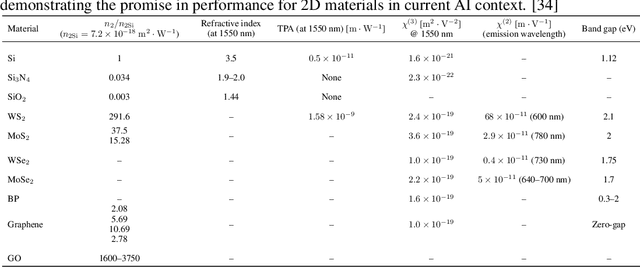
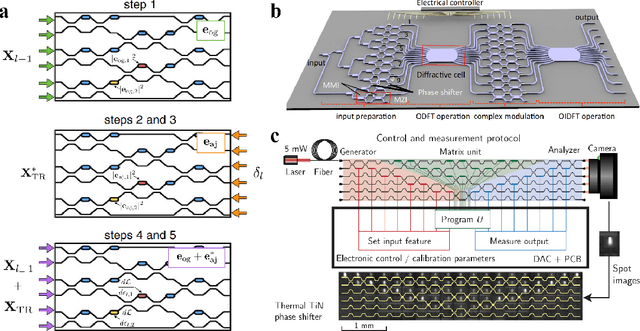

Abstract:Large language models (LLMs) are rapidly pushing the limits of contemporary computing hardware. For example, training GPT-3 has been estimated to consume around 1300 MWh of electricity, and projections suggest future models may require city-scale (gigawatt) power budgets. These demands motivate exploration of computing paradigms beyond conventional von Neumann architectures. This review surveys emerging photonic hardware optimized for next-generation generative AI computing. We discuss integrated photonic neural network architectures (e.g., Mach-Zehnder interferometer meshes, lasers, wavelength-multiplexed microring resonators) that perform ultrafast matrix operations. We also examine promising alternative neuromorphic devices, including spiking neural network circuits and hybrid spintronic-photonic synapses, which combine memory and processing. The integration of two-dimensional materials (graphene, TMDCs) into silicon photonic platforms is reviewed for tunable modulators and on-chip synaptic elements. Transformer-based LLM architectures (self-attention and feed-forward layers) are analyzed in this context, identifying strategies and challenges for mapping dynamic matrix multiplications onto these novel hardware substrates. We then dissect the mechanisms of mainstream LLMs, such as ChatGPT, DeepSeek, and LLaMA, highlighting their architectural similarities and differences. We synthesize state-of-the-art components, algorithms, and integration methods, highlighting key advances and open issues in scaling such systems to mega-sized LLM models. We find that photonic computing systems could potentially surpass electronic processors by orders of magnitude in throughput and energy efficiency, but require breakthroughs in memory, especially for long-context windows and long token sequences, and in storage of ultra-large datasets.
GaussianCAD: Robust Self-Supervised CAD Reconstruction from Three Orthographic Views Using 3D Gaussian Splatting
Mar 07, 2025



Abstract:The automatic reconstruction of 3D computer-aided design (CAD) models from CAD sketches has recently gained significant attention in the computer vision community. Most existing methods, however, rely on vector CAD sketches and 3D ground truth for supervision, which are often difficult to be obtained in industrial applications and are sensitive to noise inputs. We propose viewing CAD reconstruction as a specific instance of sparse-view 3D reconstruction to overcome these limitations. While this reformulation offers a promising perspective, existing 3D reconstruction methods typically require natural images and corresponding camera poses as inputs, which introduces two major significant challenges: (1) modality discrepancy between CAD sketches and natural images, and (2) difficulty of accurate camera pose estimation for CAD sketches. To solve these issues, we first transform the CAD sketches into representations resembling natural images and extract corresponding masks. Next, we manually calculate the camera poses for the orthographic views to ensure accurate alignment within the 3D coordinate system. Finally, we employ a customized sparse-view 3D reconstruction method to achieve high-quality reconstructions from aligned orthographic views. By leveraging raster CAD sketches for self-supervision, our approach eliminates the reliance on vector CAD sketches and 3D ground truth. Experiments on the Sub-Fusion360 dataset demonstrate that our proposed method significantly outperforms previous approaches in CAD reconstruction performance and exhibits strong robustness to noisy inputs.
SyncAnimation: A Real-Time End-to-End Framework for Audio-Driven Human Pose and Talking Head Animation
Jan 24, 2025Abstract:Generating talking avatar driven by audio remains a significant challenge. Existing methods typically require high computational costs and often lack sufficient facial detail and realism, making them unsuitable for applications that demand high real-time performance and visual quality. Additionally, while some methods can synchronize lip movement, they still face issues with consistency between facial expressions and upper body movement, particularly during silent periods. In this paper, we introduce SyncAnimation, the first NeRF-based method that achieves audio-driven, stable, and real-time generation of speaking avatar by combining generalized audio-to-pose matching and audio-to-expression synchronization. By integrating AudioPose Syncer and AudioEmotion Syncer, SyncAnimation achieves high-precision poses and expression generation, progressively producing audio-synchronized upper body, head, and lip shapes. Furthermore, the High-Synchronization Human Renderer ensures seamless integration of the head and upper body, and achieves audio-sync lip. The project page can be found at https://syncanimation.github.io
Learning from Mistakes: Self-correct Adversarial Training for Chinese Unnatural Text Correction
Dec 23, 2024Abstract:Unnatural text correction aims to automatically detect and correct spelling errors or adversarial perturbation errors in sentences. Existing methods typically rely on fine-tuning or adversarial training to correct errors, which have achieved significant success. However, these methods exhibit poor generalization performance due to the difference in data distribution between training data and real-world scenarios, known as the exposure bias problem. In this paper, we propose a self-correct adversarial training framework for \textbf{L}earn\textbf{I}ng from \textbf{MI}s\textbf{T}akes (\textbf{LIMIT}), which is a task- and model-independent framework to correct unnatural errors or mistakes. Specifically, we fully utilize errors generated by the model that are actively exposed during the inference phase, i.e., predictions that are inconsistent with the target. This training method not only simulates potential errors in real application scenarios, but also mitigates the exposure bias of the traditional training process. Meanwhile, we design a novel decoding intervention strategy to maintain semantic consistency. Extensive experimental results on Chinese unnatural text error correction datasets show that our proposed method can correct multiple forms of errors and outperforms the state-of-the-art text correction methods. In addition, extensive results on Chinese and English datasets validate that LIMIT can serve as a plug-and-play defense module and can extend to new models and datasets without further training.
A Clinical-oriented Multi-level Contrastive Learning Method for Disease Diagnosis in Low-quality Medical Images
Apr 07, 2024Abstract:Representation learning offers a conduit to elucidate distinctive features within the latent space and interpret the deep models. However, the randomness of lesion distribution and the complexity of low-quality factors in medical images pose great challenges for models to extract key lesion features. Disease diagnosis methods guided by contrastive learning (CL) have shown significant advantages in lesion feature representation. Nevertheless, the effectiveness of CL is highly dependent on the quality of the positive and negative sample pairs. In this work, we propose a clinical-oriented multi-level CL framework that aims to enhance the model's capacity to extract lesion features and discriminate between lesion and low-quality factors, thereby enabling more accurate disease diagnosis from low-quality medical images. Specifically, we first construct multi-level positive and negative pairs to enhance the model's comprehensive recognition capability of lesion features by integrating information from different levels and qualities of medical images. Moreover, to improve the quality of the learned lesion embeddings, we introduce a dynamic hard sample mining method based on self-paced learning. The proposed CL framework is validated on two public medical image datasets, EyeQ and Chest X-ray, demonstrating superior performance compared to other state-of-the-art disease diagnostic methods.
Enhancing Texture Generation with High-Fidelity Using Advanced Texture Priors
Mar 08, 2024Abstract:The recent advancements in 2D generation technology have sparked a widespread discussion on using 2D priors for 3D shape and texture content generation. However, these methods often overlook the subsequent user operations, such as texture aliasing and blurring that occur when the user acquires the 3D model and simplifies its structure. Traditional graphics methods partially alleviate this issue, but recent texture synthesis technologies fail to ensure consistency with the original model's appearance and cannot achieve high-fidelity restoration. Moreover, background noise frequently arises in high-resolution texture synthesis, limiting the practical application of these generation technologies.In this work, we propose a high-resolution and high-fidelity texture restoration technique that uses the rough texture as the initial input to enhance the consistency between the synthetic texture and the initial texture, thereby overcoming the issues of aliasing and blurring caused by the user's structure simplification operations. Additionally, we introduce a background noise smoothing technique based on a self-supervised scheme to address the noise problem in current high-resolution texture synthesis schemes. Our approach enables high-resolution texture synthesis, paving the way for high-definition and high-detail texture synthesis technology. Experiments demonstrate that our scheme outperforms currently known schemes in high-fidelity texture recovery under high-resolution conditions.
Narrowing the semantic gaps in U-Net with learnable skip connections: The case of medical image segmentation
Dec 23, 2023
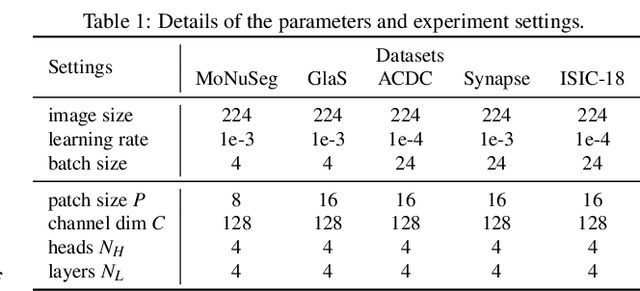
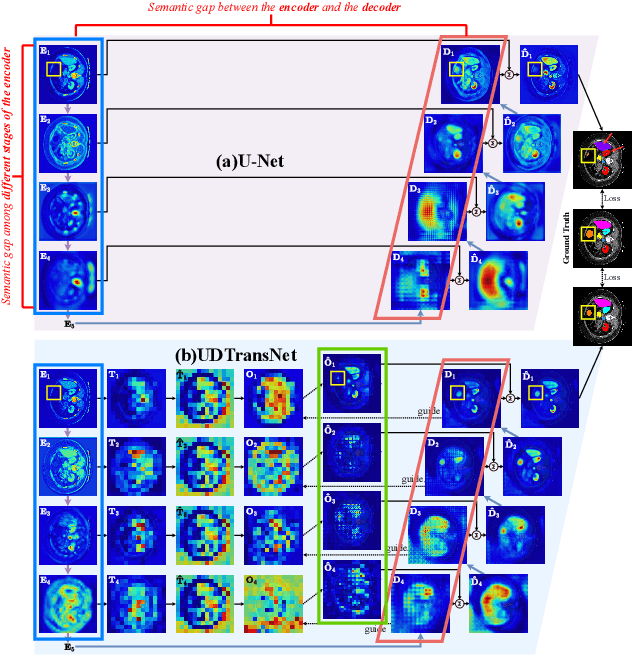

Abstract:Most state-of-the-art methods for medical image segmentation adopt the encoder-decoder architecture. However, this U-shaped framework still has limitations in capturing the non-local multi-scale information with a simple skip connection. To solve the problem, we firstly explore the potential weakness of skip connections in U-Net on multiple segmentation tasks, and find that i) not all skip connections are useful, each skip connection has different contribution; ii) the optimal combinations of skip connections are different, relying on the specific datasets. Based on our findings, we propose a new segmentation framework, named UDTransNet, to solve three semantic gaps in U-Net. Specifically, we propose a Dual Attention Transformer (DAT) module for capturing the channel- and spatial-wise relationships to better fuse the encoder features, and a Decoder-guided Recalibration Attention (DRA) module for effectively connecting the DAT tokens and the decoder features to eliminate the inconsistency. Hence, both modules establish a learnable connection to solve the semantic gaps between the encoder and the decoder, which leads to a high-performance segmentation model for medical images. Comprehensive experimental results indicate that our UDTransNet produces higher evaluation scores and finer segmentation results with relatively fewer parameters over the state-of-the-art segmentation methods on different public datasets. Code: https://github.com/McGregorWwww/UDTransNet.
MetaDreamer: Efficient Text-to-3D Creation With Disentangling Geometry and Texture
Nov 16, 2023Abstract:Generative models for 3D object synthesis have seen significant advancements with the incorporation of prior knowledge distilled from 2D diffusion models. Nevertheless, challenges persist in the form of multi-view geometric inconsistencies and slow generation speeds within the existing 3D synthesis frameworks. This can be attributed to two factors: firstly, the deficiency of abundant geometric a priori knowledge in optimization, and secondly, the entanglement issue between geometry and texture in conventional 3D generation methods.In response, we introduce MetaDreammer, a two-stage optimization approach that leverages rich 2D and 3D prior knowledge. In the first stage, our emphasis is on optimizing the geometric representation to ensure multi-view consistency and accuracy of 3D objects. In the second stage, we concentrate on fine-tuning the geometry and optimizing the texture, thereby achieving a more refined 3D object. Through leveraging 2D and 3D prior knowledge in two stages, respectively, we effectively mitigate the interdependence between geometry and texture. MetaDreamer establishes clear optimization objectives for each stage, resulting in significant time savings in the 3D generation process. Ultimately, MetaDreamer can generate high-quality 3D objects based on textual prompts within 20 minutes, and to the best of our knowledge, it is the most efficient text-to-3D generation method. Furthermore, we introduce image control into the process, enhancing the controllability of 3D generation. Extensive empirical evidence confirms that our method is not only highly efficient but also achieves a quality level that is at the forefront of current state-of-the-art 3D generation techniques.
Evaluating the Adversarial Robustness of Convolution-based Human Motion Prediction
Jul 03, 2023Abstract:Human motion prediction has achieved a brilliant performance with the help of CNNs, which facilitates human-machine cooperation. However, currently, there is no work evaluating the potential risk in human motion prediction when facing adversarial attacks, which may cause danger in real applications. The adversarial attack will face two problems against human motion prediction: 1. For naturalness, pose data is highly related to the physical dynamics of human skeletons where Lp norm constraints cannot constrain the adversarial example well; 2. Unlike the pixel value in images, pose data is diverse at scale because of the different acquisition equipment and the data processing, which makes it hard to set fixed parameters to perform attacks. To solve the problems above, we propose a new adversarial attack method that perturbs the input human motion sequence by maximizing the prediction error with physical constraints. Specifically, we introduce a novel adaptable scheme that facilitates the attack to suit the scale of the target pose and two physical constraints to enhance the imperceptibility of the adversarial example. The evaluating experiments on three datasets show that the prediction errors of all target models are enlarged significantly, which means current convolution-based human motion prediction models can be easily disturbed under the proposed attack. The quantitative analysis shows that prior knowledge and semantic information modeling can be the key to the adversarial robustness of human motion predictors. The qualitative results indicate that the adversarial sample is hard to be noticed when compared frame by frame but is relatively easy to be detected when the sample is animated.
 Add to Chrome
Add to Chrome Add to Firefox
Add to Firefox Add to Edge
Add to Edge